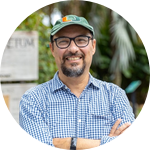About This Project
How do large mammals affect forest carbon in tropical forests? Quantifying the effects of wildlife on forest carbon is fundamental to mitigating climate change. Based on a long-term fencing experiment where I have excluded large mammals for more than 12 years, I will measure the effects of large mammals on forest (soil and plant) carbon in tropical forests of Brazil. My results will be important to estimate the value of tropical mammals' services on forest carbon.
Ask the Scientists
Join The DiscussionWhat is the context of this research?
Most carbon mitigation projects focus on planting trees, but the value of animals in carbon sequestration is unappreciated. This project will fill a gap in the role of tropical large mammals on rainforest carbon and will open an avenue of possibilities to quantify their ecosystem services.
What is the significance of this project?
We urgently need to mitigate the effects of climate change and understand the monetary value of the animals on the carbon sequestration. This is particularly important in global forums and for biodiversity-rich countries that have immense natural capital and low carbon emissions. We still have a bare idea of the value of wild animals on carbon sequestration and the existing models are based on few species. This project will estimate the monetary value on the services of wild animals on carbon sequestration of a myriad of large mammal species in tropical rainforests and can be a fundamental tool for IPCC and other environmental agencies to manage the world's carbon storage.
What are the goals of the project?
The ultimate goal is to monetize the ecosystem services provided by large mammals on forest carbon in tropical rainforests. How much worth the service of tapirs or peccaries in soil and forest carbon? To do so, I will use a series of fenced and unfenced plots in 4 Protected Parks in the Atlantic Forest of Brazil.
I will collect, analyze and compare soil carbon concentration in 86 paired forest plots where wild animals were excluded in the last 12 years, with plots where they can forage. By comparing the soil carbon in open and control plots I can estimate the value of wild animals on soil carbon using the value of carbon in the market.
Budget
This budget will cover the whole project. I will spend 30 days in 4 Protected Parks in the Atlantic forest of Sao Paulo where 86-exclosure experimental plots have been established 12 years ago and I will collect soil samples for each plot. This amount will cover field work and soil analysis.
Endorsed by
 Project Timeline
Project Timeline
September - Travel to Brazil, and collect soil samples in 86 plots. Send this soil samples to a lab. to quantify their concentrations. I will spend 5 days in 4 sites in the Atlantic forests of Brazil collecting soil samples in an already established long-term experiment.
The soil samples will be send to a Brazilian laboratory and will take 2 weeks to have the results.
Jun 20, 2022
Project Launched
Sep 07, 2022
Travel to Brazil
Sep 12, 2022
Install camera traps
Sep 12, 2022
Travel to the field
Sep 13, 2022
Collect soil samples
Meet the Team
Mauro Galetti
I was lucky to be born and raised in the most biodiverse country on Earth: Brazil. Since my childhood, I was surrounded by exquisite birds and plants and I think becoming a biologist was a natural step in my life. As an instructor, I try to motivate students to learn and experience nature and understand that human-well being is totally dependent on our natural capital.
Project Backers
- 4Backers
- 1%Funded
- $38Total Donations
- $9.50Average Donation



